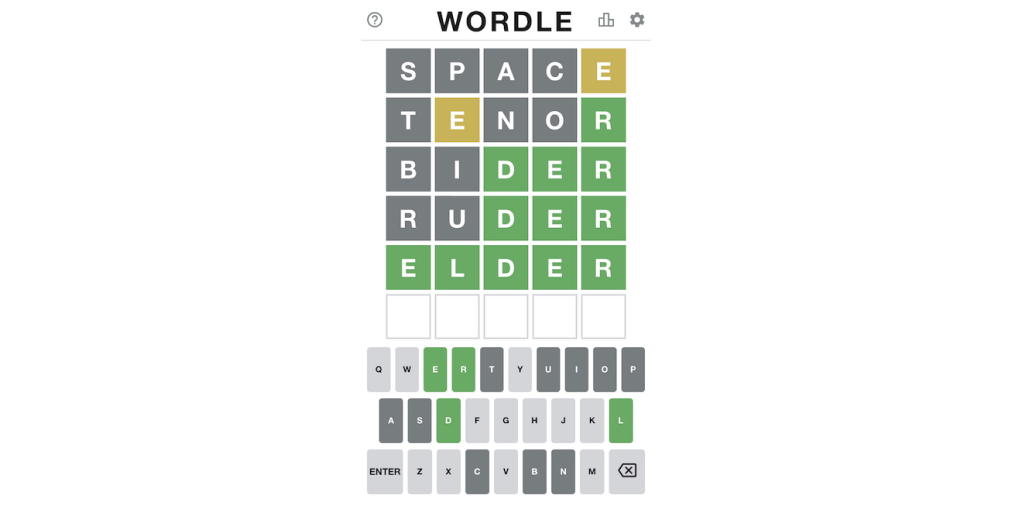In the midst of hype cycles around web3 and the metaverse, the thing that captured the internet’s attention span the last two months has been Wordle — a delightfully simple web-based word guessing game.
What is Wordle?
The game by now needs little introduction: you get six tries to guess a five letter word, and clues tell you when you guess a letter correctly. That’s it. The interface and gamification is minimal; you can’t log in, and you can only play once a day.

Wordle took off in mid-December 2021, and for the past seven weeks millions of people have joined in on playing the game — sharing their results on Twitter and other social media. This fast rise in the online zeitgeist prompted The New York Times to buy Wordle for a number in the “low seven figures.”
Why Wordle succeeded
In our web design trends for 2022, we noted that “mini-sites of delight,” like Wordle, would become increasingly popular. But how did Wordle create such a popular web experience? Here are some important lessons we can take away from its success.
Tailor-made for a specific audience
Wordle creator Josh Wardle and his partner Palak Shah are big fans of word games, so Josh geared Wordle specifically for Palak’s taste in games — simple, enjoyable, and with recognizable words. By focusing on such a specific type of word-game fan, Josh kept a clean focus on delight and minimizing frustration. After all, there’s nothing more annoying than an esoteric crossword clue that leaves you stumped.
A simple UX
Wordle is incredibly easy to pick up. You get two types of clues (one for guessing a correct letter, another for guessing a letter in the correct place), and there are only two levels of difficulty. The keyboard embedded on the page keeps track of what letters you’ve guessed, and there’s no need to deal with the sometimes awkward experience of using the default keyboard.
The game is also built with accessibility in mind, offering a high contrast color mode for color blind users to play with blue and orange letter blocks instead of the default green-yellow.
There’s no profile to create, no ads or pop-ups, and the game remembers if you have a streak going. By having little for the players to think about regarding the mechanics of the game, Wordle builds instant familiarity and anticipation for the gameplay each day.
The game respects people’s time
This piece by Joe Bernstein puts Wordle’s relationship to time perfectly:
"Unlike many of the other aesthetically pleasing, dopamine-boosting apps and games that surround us, Wordle gives us strict limits. We get one word per day, refreshing at midnight local time. Once you’ve consumed your six-or-fewer guesses for the day, that’s it. You’re done until the next midnight rolls around. No infinite scrolling. No incentive to play with new words or improve your score. No freemium model to speed up your wait for the next word. It’s… refreshing."
By embracing limits, Wordle became a game people wanted to return to.
Super shareable and discussion inducing
Added a share button to Wordle that generates a spoiler-free emoji grid for you. Shoutout to @irihapeta for inventing such a cool way to share your results each day.
— Josh Wardle (@powerlanguish) December 16, 2021
👇
⬛⬛⬛⬛⬛
🟨⬛🟨🟩⬛
🟩🟩🟩🟩🟩
Wordle 180 3/6
Try it out: https://t.co/pZTmeT1p7E
Wordle took off after Josh built a sharing feature, which he added once he noticed a couple players sharing color-coded emojis on Twitter to show off their guess history. The sharing feature includes no URL, so this means the game has grown only those deliberately seeking it out. The emoji pattern is eye-catching and naturally prompts players to reach out and discuss their approaches to solving the word of the day. At companies across the world, Slack channels have been set up for people to share their Wordle guesses (ours at Webflow has 50 people in it).
It’s remixable
Almost as instantly as it rose, Wordle attracted copycats. But it also attracted strong defendants, including Apple, which removed Wordle clones seeking to profit from the original’s popularity on the App Store. There were also devotees who created homages to Wordle in other languages, a version that embraced colorful, more explicit language, a geographic version, and even a satirical one-letter version.
While people value the original (Apple taking out clones), many used it as inspiration (other languages, Sweardle) which ultimately helped draw eyes back to the original.
Built for scale
Yes, Wordle is relatively simple, but it was originally on an independent hosting company’s servers. Once the game went viral, Josh got help from a friend to move it onto Cloudflare and Amazon S3 for hosting. Thanks to modern software, it’s never been easier to create a game on the web. One of our recent favorites includes this game where the object for players is to put Wikipedia articles in the correct chronological order.
The final word
It would have been easy for Josh to leverage the near-instant popularity of Wordle with venture funding. But doing so would have meant needing to create growth ambitions and change key aspects of a game that people love. We’ll see what the future holds with the New York Times acquisition and how the game changes as a result, but there’s no doubt that Wordle has inspired web creators across the globe to create delightful experiences.



















Build websites that get results.
Build visually, publish instantly, and scale safely and quickly — without writing a line of code. All with Webflow's website experience platform.































